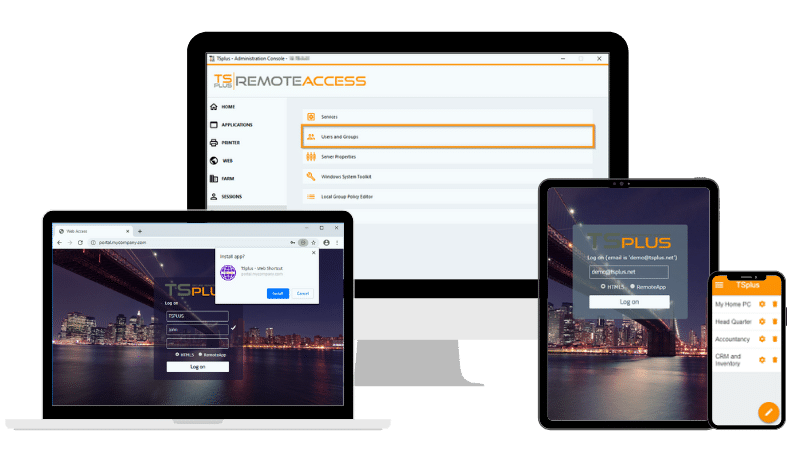)
)
What Is Remote Desktop on Mac and Why It Matters?
As IT environments become increasingly diverse, the ability to bridge operating systems is essential. macOS users in enterprise or hybrid setups often require remote access to Windows-based systems—whether for administration, application access, or virtual infrastructure management. This is where Remote Desktop Protocol (RDP) becomes critical.
Remote Desktop on Mac refers to the use of client software (such as Microsoft Remote Desktop) that allows macOS devices to establish a connection to remote Windows machines using RDP. This cross-platform functionality ensures business continuity and operational efficiency in environments where Windows remains a server or application backbone.
RDP vs VNC and SSH on Mac
While RDP is Windows-native, other protocols like VNC (Virtual Network Computing) and SSH (Secure Shell) are often used for remote access. However:
- RDP: Offers GUI-based control of Windows systems with full session interactivity.
- VNC: Platform-independent but lacks session management and advanced features.
- SSH: Best for command-line control on Unix-like systems but not GUI-based.
Best Practice: For enterprise-grade Windows access from macOS, RDP offers the highest performance, the most robust session control, and the deepest integration with enterprise infrastructure.
Common Use Cases
IT professionals, developers, and support technicians rely on RDP connections from Mac to Windows for a wide variety of mission-critical tasks.
- Administering Windows Server from a Mac.
- Accessing internal business applications hosted on Windows.
- Remote IT troubleshooting and support.
- Connecting to VM environments (e.g., Hyper-V or Azure VMs).
Knowing when and how to use RDP over other protocols allows IT teams to optimize both performance and user experience.
Why This Matters for IT Operations
In many enterprises, Mac devices are standard-issue for developers, designers, and remote teams, while Windows continues to power backend systems, file servers, and domain controllers. Remote Desktop on Mac enables:
- Cross-platform compatibility without virtualization overhead.
- Centralized administration from anywhere, reducing time-to-resolution for incidents.
- Cost savings by avoiding redundant hardware or OS licenses.
- Improved security through controlled access to remote resources rather than full network exposure.
RDP empowers Mac users to work seamlessly in Windows-centric environments—enabling centralized IT management and platform flexibility without compromising performance or security.
Step 1: Installing Microsoft Remote Desktop on Mac
To initiate RDP connections, macOS users need Microsoft’s Remote Desktop client, which is officially supported and regularly updated.
Where to Find It
- Navigate to the Mac App Store.
- Search for Microsoft Remote Desktop.
- Download and install the latest version (currently Microsoft Remote Desktop 10+).
Note: Ensure you're running macOS 10.14 (Mojave) or later for full compatibility with modern Remote Desktop features.
Security Considerations
Upon installation, macOS may prompt for permission to access the microphone, camera, and drives. These are used for device redirection and should be evaluated based on corporate security policies.
It’s good practice to install via a managed MDM solution (like Jamf or Intune) for enterprise environments.
Update Best Practices
Keep the RDP client up to date to benefit from performance enhancements, security patches, and new features like gateway support or clipboard synchronization.
Step 2: Preparing the Windows Host for RDP Access
Before a Mac can connect, the target Windows machine must be correctly configured to accept incoming RDP sessions.
Enabling Remote Desktop
- On the Windows machine, open:
- Start Menu → Settings → System → Remote Desktop.
- Toggle Enable Remote Desktop to ON.
- Click Confirm when prompted.
Behind the scenes, this action modifies Group Policy and opens port 3389 in the Windows Firewall.
User Permissions
Only users with appropriate permissions can connect. Verify:
- The user account is part of the Remote Desktop Users group.
- For domain environments, ensure Group Policy allows remote access.
powershell:
# Add a user to Remote Desktop Users via PowerShell:
Add-LocalGroupMember -Group "Remote Desktop Users" -Member "username"
Network and Firewall Configuration
- Port 3389 must be open (inbound) in Windows Defender Firewall or any third-party firewall.
- If connecting over a WAN/VPN, ensure NAT and routing are properly configured.
System Power Settings
Prevent the host from sleeping during idle time:
- Settings → System → Power & Sleep → Set to "Never" for both battery and plugged-in.
Step 3: Configuring the Remote Desktop Connection on macOS
With both endpoints ready, you’ll now set up the connection in the Microsoft Remote Desktop client on your Mac.
Adding a New PC
- Open the app.
- Click the "+" icon → Add PC.
- Enter the hostname (FQDN or IP address).
- Under User Account, either:
- Use Ask Every Time.
- Add a pre-saved account (for single sign-on scenarios).
Optional PC Settings
- Friendly Name: Label the connection for easy recognition.
- Gateway: If connecting through an RD Gateway (often required for external access), specify credentials and URL.
- Group: Organize by environments or departments.
Device and Folder Redirection
In the Folders tab:
- Redirect local folders for seamless file transfer.
- Redirect clipboard and printers if needed.
Performance Tip: For slow connections, disable “Reconnect if the connection is dropped” and reduce session resolution.
Step 4: Connecting and Optimizing Your Remote Session
Initiating the Connection
- Double-click the saved PC entry.
- Accept the self-signed certificate if prompted (you may trust it permanently).
- You will now enter a full-screen or windowed remote session.
Session Controls
- Use the toolbar to:
- Toggle full screen.
- Access session settings.
- Switch between sessions if using multiple concurrent RDP connections.
Keyboard Mapping
macOS keyboards differ from Windows layouts. For example:
- Cmd acts as Ctrl.
- To simulate Ctrl+Alt+Del, use the top menu: Session → Send Ctrl+Alt+Del.
Advanced users can configure custom keybindings in Preferences > Keyboard Shortcuts.
TSplus Remote Access - A Mac-to-Windows RDP
While Microsoft Remote Desktop is a solid choice for individual users and small-scale scenarios, it can become limited in enterprise environments that demand flexibility, scalability, and seamless web access. TSplus Remote Access addresses these challenges by offering a powerful, browser-based remote desktop solution that requires no client installation.
Through its HTML5 web portal, users on macOS, Linux, Windows, or mobile devices can securely access full Windows desktops or publish individual Windows applications for streamlined use. TSplus also features advanced security protocols, including HTTPS encryption, two-factor authentication, and IP filtering, ensuring data protection across all sessions.
Conclusion
Opening Remote Desktop on Mac is more than just a connectivity task—it's an essential bridge for managing enterprise-grade infrastructure from any location. With the right setup and tools, IT professionals can ensure secure, high-performance access between macOS and Windows systems.
Whether you're using the official Microsoft Remote Desktop client or looking for a more flexible and scalable solution like TSplus, you now have a complete understanding of how to deploy RDP on Mac—securely and efficiently.

TSplus Remote Access Free Trial
Ultimate Citrix/RDS alternative for desktop/app access. Secure, cost-effective, on-premises/cloud














)
)
)